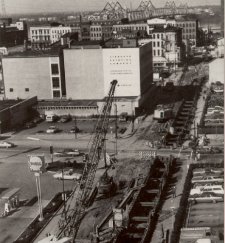Louisville was bustling with activity in 1972. Urban renewal was transforming the downtown area, for better or for worse. Actors Theatre moved from the riverfront to a new location on Main Street, making way for the new Riverside Expressway. Ground was being cleared and prepared for the Riverfront Belvedere. Fourth Street was closed to traffic and would soon be converted to a pedestrian mall.
In the suburbs, Bashford Manor Mall opened and soon became the busiest shopping center in the area. The number of cities in Jefferson County topped 70. And the population of Jefferson County outside Louisville was about to exceed the population of Louisville itself.
Few could predict the crises and changes the 1970s would bring, for Louisville and Jefferson County as well as the world.
The Arab oil embargo and the related "energy crisis" disrupted the economy of the nation and doubled the cost of living in less than a dozen years. The President of the United States resigned under duress. Iran held U.S. citizens as hostages.
In Louisville, a tornado churned through the city, causing widespread damage but mercifully causing few deaths and injuries. The city and county schools systems merged, then faced contentious and divisive court-ordered desegregation. Louisville teachers went on strike, and then Louisville firefighters.
It was also a time of crises for MSD — critical programs got off track, and several disasters created a crisis in public confidence.

Courier-Journal and Louisville Times Photo by James N. Keen
The Morris Forman Plant
Construction of the secondary treatment works at the Morris Forman plant began in May, 1972; completion was scheduled for July 31, 1974. But by the time the completion date rolled around, construction was 300 days behind schedule.
The construction delays continued, through 1975 and early 1976. The plant was finally dedicated in July, 1976, nearly two years behind schedule. Then the operating problems began.
The first big problem was the $7 million incinerator for burning sludge, the processed solid material that had been removed from the wastewater. When the incinerator was fired up the first time — by the contractors, because MSD hadn’t accepted it yet — it sent a terrible stench over western Louisville and the downtown area.
To make matters worse, the proper air pollution control steps weren’t taken before the tests. And despite repeated modifications, the incinerators couldn’t meet emissions standards. Then the rapidly rising costs of fuel caught up with the project; it became more economical to dispose of the sludge in a landfill.
The incinerator wasn’t the only problem; there were troubles with many parts of the new facility. By the end of July, 1977 — the original federal deadline for meeting secondary treatment standards — only 62 percent of the wastewater was getting the full secondary treatment.
Negotiations with the engineers, construction contractors and equipment suppliers failed to produce satisfactory results, and in March, 1978, the MSD board authorized hiring an independent engineering consultant and outside legal counsel to look into the situation. Then critical pumps failed during high water on the Ohio River, and the secondary treatment facility was shut down.
Soon the matter was in court. The Environmental Protection Agency filed suit against MSD, asking the court to schedule repairs and giving MSD 45 days to resume operation. Next, the construction contractors, Blount Brothers Corp. of Montgomery, Ala., filed suit against MSD, seeking $3 million. And in August, MSD filed suit against Blount Brothers and the designers of the plant, Consoer, Townsend & Associates of Chicago, for $43 million — and asked that they be required to pay any fines assessed against MSD because the plant failed to meet federal standards.
That summer, MSD and the Environmental Protection Agency worked out a preliminary timetable for making improvements at the plant; MSD asked for an extension of the secondary-treatment deadline to July, 1983, as allowed by federal law. More than two years later, in December, 1980, MSD and EPA reached an agreement on modifications and repairs at the plant, settling the court case. The agreement was revised in December, 1981.
Also in December, 1981, the designers of the plant reached an out-of-court settlement, agreeing to pay MSD slightly more than $2 million.
The plant went into full operation in early 1980, but couldn’t meet federal standards. Repairs took years and cost $14 million. Finally, in the summer of 1985, eight years after the original deadline, the plant met the federal secondary treatment standards for the first time.
And in August, 1986, Blount Brothers agreed to pay MSD $4.5 million to settle the remaining lawsuits. The secondary treatment crisis was over — but MSD would have to make more improvements at the plant to meet new federal regulations and to perform on a consistent basis.
MSD History continued - The Countywide Sewer Plan


